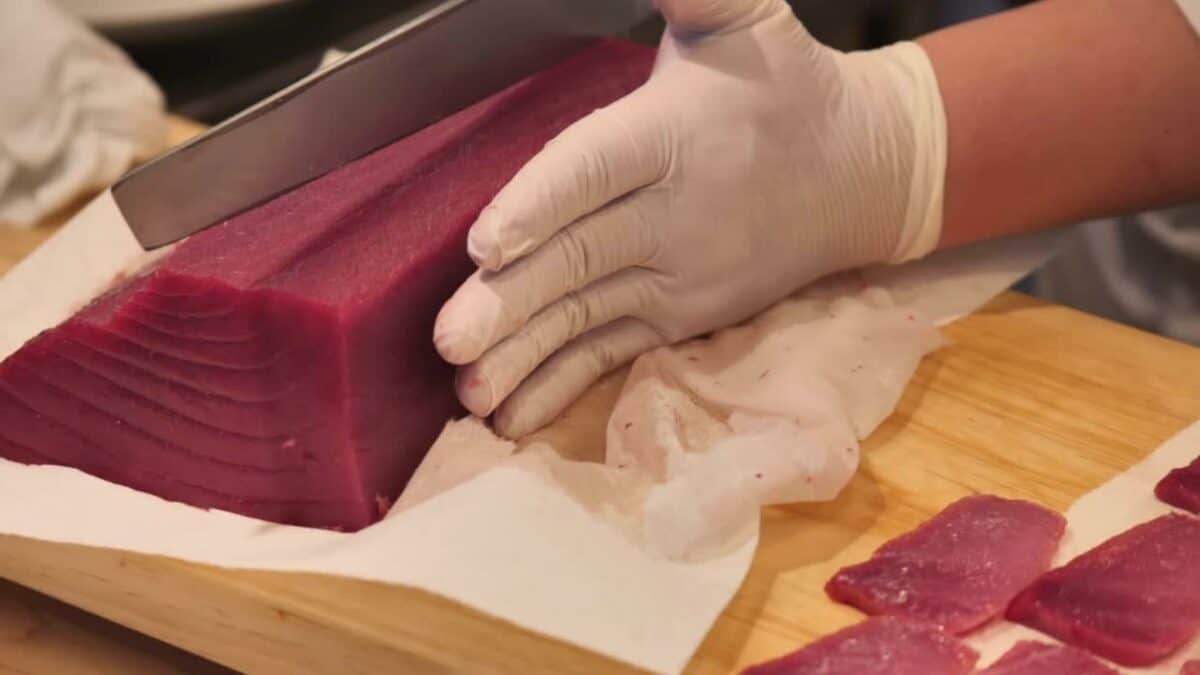Takobiki: What Is This Sashimi Knife?
Takobiki or Tako hiki (タコ引, literally, octopus-puller) is a long thin Japanese knife.
It belongs to the group of Sashimi bōchō (Japanese: 刺身包丁Sashimi [raw fish] bōchō [knife]) together with the yanagi ba (柳刃, literally, willow blade), and fugu hiki (ふぐ引き, literally, pufferfish-puller).
These types of knives are used to prepare sashimi, sliced raw fish, and seafood.

It’s similar to the nakiri bocho, the style differs slightly between Tokyo and Osaka. In Osaka, the yanagi ba has a pointed end, whereas in Tokyo the tako hiki has a rectangular end.
The tako hiki is usually used to prepare octopus. A fugu hiki is similar to the yanagi ba, except that the blade is thinner and more flexible.
As the name indicates, the fugu hiki is traditionally used to slice very thin fugu sashimi. The length of the knife is suitable to fillet medium sized fish.
Specialized knives exist for processing longer fish, such as American tuna. Such knives include the almost two-meter long oroshi hocho, or the slightly shorter hancho hocho.

Check out our new cookbook
Bitemybun's family recipes with complete meal planner and recipe guide.
Try it out for free with Kindle Unlimited:
Read for freeIn this post we'll cover:
What is a Takobiki knife?
The Takobiki is a Japanese slicing knife also known as an “octopus cutter”.
This slicing knife has a long narrow blade and a blunt tip. Its weight allows it to slice through harder-to-cut foods like octopus.
Octopus flesh is very slippery which makes it difficult to slice with a regular kitchen knife.
The Takobiki’s long blade and weight help to counter the slippery texture. It also helps the user remove the head and carve it out.
The Takobiki is a fish-slicing knife used to fillet and slice fish and other seafood into super thin slices for sashimi and sushi.
You can easily slice paper-thin slices with this knife.
It can also be used to fillet chicken, pork, and other meats but its blunt tip is what makes it unique.
The Takobiki knife is one of the three traditional Japanese slicing knives. The others are the Yanagiba and the Deba.
All three knives are used for different purposes depending on the type of food being cut.
Takobiki vs Yanagi
The takobiki knife resembles the yanagi knife; in fact, they’re fairly similar in both appearance and functionality.
The main difference is that a Takobiki knife is thinner and narrower.
It’s also a bit lighter and thus quite delicate. It allows for extreme precision when slicing fish.
The Yanagiba, on the other hand, is a bit thicker and heavier. It’s designed for cutting through larger chunks of flesh.
Both work for cutting octopus but the Takobiki is better suited for slicing paper-thin slices of fish and cleaning octopus.
One reason why chefs like the Takobiki is that you can make long uninterrupted strokes and use traditional techniques to slice and fillet.
Thus, the flatter blade profile better protects the flesh and integrity of the food.
When you make the sushi or sashimi it will look perfect and ready to serve, even for the pickiest customer.
Another important difference to note is that the yanagi knife has a sharp tip, not a blunt one like the Takobiki.
The blunt tip on the Takobiki is what allows it to excel in slicing octopus. It’s also effective
History of the Takobiki knife
Minosuke Matsuzawa, the Masamoto Sohonten company’s founder, created and originally crafted the takobiki as an adaptation of the traditional yanagiba knife.
It is used to cut boneless fish fillets into sashimi and is the Kanto area (Tokyo) adaptation of the Yanagi knife.
According to Japanese legend, chefs would not point the sword-like Yanagi toward their patrons, especially aristocrats, when preparing sashimi in front of guests centuries ago and that’s why they decided on a blunt tip as opposed to the razor-sharp tip of yanagi knives.
For this reason, older eateries in Tokyo still employ Takobiki knives rather than Yanagi ones nowadays.
Compared to the Yanagi, its narrow body makes cutting thin fish slices easier.
Takobiki, which translates to “octopus cutter,” refers to how well the blunt tip and balanced weight perform on challenging components like an octopus.
What is a Japanese slicing knife called? Sujihijki vs Takobiki
A traditional Japanese slicing knife is called a sujihiki knife.
It is similar to a Western-style slicing knife, but typically has a much sharper blade and a thinner blade profile.
Sujihiki knives are not the same as Takobiki knives.
Takobiki knives are a specific type of Japanese slicing knife that is designed for slicing fish and other seafood, mainly octopus.
While Sujihiki knives can be used for the same purpose, they are not as effective as Takobiki knives.
What is a slicer knife used for?
The Japanese slicing knife is used for many cooking tasks.
It is perfect for slicing meat, fish, octopus, and vegetables. It can also be used to fillet chicken, pork, and other meats.
The Takobiki is used to cut, clean, and slice fresh octopus for recipes such as Takoyaki and Takosenbei.
The Yanagiba is used to fillet fish such as tuna, salmon, and snapper.
The Deba is used to cut through the bone of fish and chicken. It can also be used to fillet fish.
Check out our new cookbook
Bitemybun's family recipes with complete meal planner and recipe guide.
Try it out for free with Kindle Unlimited:
Read for freeJoost Nusselder, the founder of Bite My Bun is a content marketer, dad and loves trying out new food with Japanese food at the heart of his passion, and together with his team he's been creating in-depth blog articles since 2016 to help loyal readers with recipes and cooking tips.
